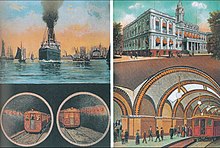Joralemon Street Tunnel

|
|
| Overview | |
|---|---|
| Line | IRT Lexington Avenue Line (4 5 trains) |
| Location | East River between Manhattan, New York and Brooklyn, New York |
| Coordinates | 40°41′49″N 74°00′26″W / 40.69694°N 74.00722°WCoordinates: 40°41′49″N 74°00′26″W / 40.69694°N 74.00722°W |
| System | New York City Subway |
| Operation | |
| Opened | January 9, 1908 |
| Operator | Metropolitan Transportation Authority |
| Technical | |
| No. of tracks | 2 |
|
Joralemon Street Tunnel
|
|
| Architect | William Barclay Parsons; Andrew McDonald, et al. |
| MPS | New York City Subway System MPS |
| NRHP Reference # | 06000015 |
| Added to NRHP | February 9, 2006 |
The Joralemon Street Tunnel, originally called the Brooklyn-Battery Tunnel, carries the 4 5 trains of the IRT Lexington Avenue Line of the New York City Subway under the East River from the Bowling Green neighborhood (State Street) in Manhattan to Joralemon Street and Willow Place in Brooklyn. It was the first underwater subway tunnel connecting Manhattan and Brooklyn, with construction taking place between 1903 and 1907.
The tunnel was constructed using the shield method and consists of two parallel cast iron tubes 2,170 feet long. Construction problems led to alignment issues, resulting in the reconstruction of large segments of the tunnel to ensure safe subway operations. A construction accident on March 28, 1905 in the pressurized tunnel, led to a blowout which propelled a worker through the mud and 40 feet into the air. The construction of the tunnel also saw the conversion of 58 Joralemon Street into a fan plant (a type of ventilation building) and emergency exit for the IRT subway system.Clifford Milburn Holland served as the assistant engineer during the construction of the tunnel. The first train ran through the Joralemon Street Tunnel to Brooklyn about 12:45 a.m. on January 9, 1908.
The tunnel was the site of a derailment on March 17, 1984.
The Joralemon Street Tunnel was one of seven East River subway tunnels flooded on October 29, 2012 as Hurricane Sandy's storm surge inundated Lower Manhattan. The Joralemon and Rutgers Street Tunnel were MTA's priority to drain and return to operations, as they carry some of the system's busiest routes. The storm water was cleared from the tunnel on October 31, inspected and awaiting Con Edison service to be restored. Full-length subway service through the tunnel was restored at 10:00 am on November 3.
...
Wikipedia
